Cultivating Virtue: Japan
Post #843 • August 2, 2006, 1:08 PM • 3 Comments
More images from Cultivating Virtue at the Sackler. Also note that the first entry has been updated with a new image.
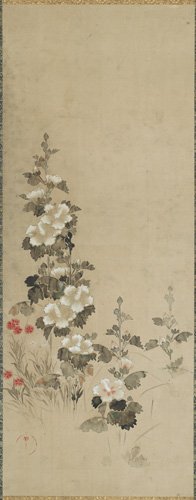
Attributed to Kitagawa Sosetsu (active mid-17th century), Hollyhocks and Pinks, Japanese; Edo period, mid 17th century. Hanging scroll; ink and colors on paper; with imperfectly impressed seal perhaps reading "Inen," "Roshu," or "Sosetsu," 104.5 x 40.3 cm. Courtesy of the Arthur M. Sackler Museum, Harvard University Art Museums. Anonymous Fund, 1964. Photo: Photographic Services © President and Fellows of Harvard College.
I admire the application of paint in Rinpa-style work, in which ink and mineral pigements are applied wet on wet to produce these attractive pools of color.
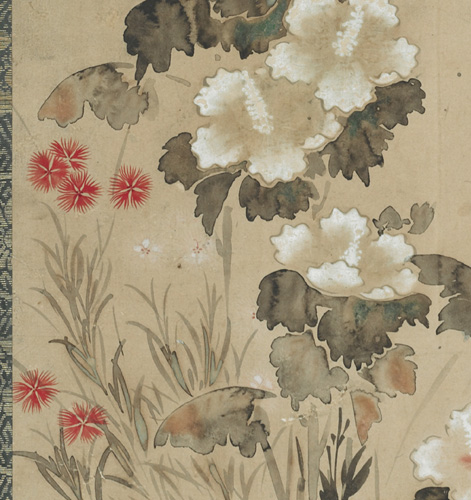
Above, detail.
The technique is called tarashikomi. Where did it come from? Personally, I think it wouldn't be crazy to suggest that they were trying to approximate effects they had seen accomplished by ceramists and lacquer artists, whom they worked alongside at the time.
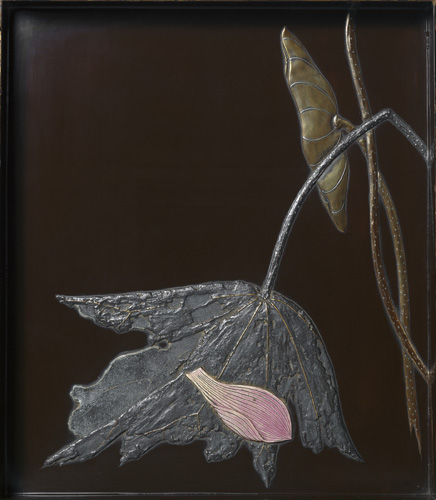
Attributed to Ogawa Haritsu (1663-1747), Lotus-Decorated Interior of a Lid from a Document Box (Ryoshibako) with Gong, Vajra, and Sutra Design, Japanese; Edo period, late 17th to early 18th century. Lacquer on wood with decoration in gold and "sabi urushi" (thick lacquer paste) utilizing the "hiramaki-e" (low-relief sprinkled design) and "takamaki-e" (high-relief sprinkled design) techniques, and with glazed-ceramic and tortoiseshell inlays, 10 x 22.2 x 25.1 cm. Courtesy of the Arthur M. Sackler Museum, Harvard University Art Museums. The Elaine Ehrenkranz Collection of Japanese Lacquer Boxes; Gift of Elaine Ehrenkranz, 1996. Photo: Photographic Services © President and Fellows of Harvard College.
In comparison to the Kitagawa above, this piece is a bit stiff.
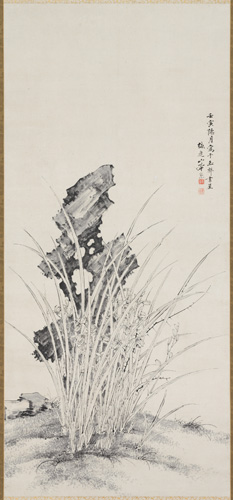
Yamamoto Baiitsu (1783-1856), Orchids, Brambles, and Garden Rock, Japanese; Edo period, dated to 1842. Hanging scroll; ink on paper; with signature reading "Baiitsu Yamamoto ryo," 120.4 x 55.2 cm. Courtesy of the Arthur M. Sackler Museum, Harvard University Art Museums. Bequest of the Hofer Collection of the Arts of Asia, 1985. Photo: Photographic Services © President and Fellows of Harvard College.
However, this is ink, and painting that rock behind the bamboo is what computer guys call non-trivial.
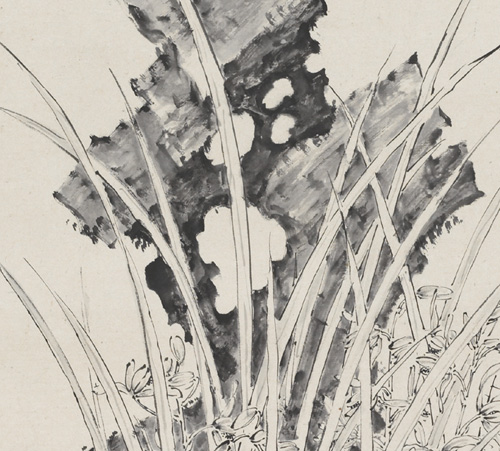
Above, detail.
Okay. Time to curl up for a nap in the refrigerator.
2.
August 2, 2006, 6:51 PM
That's astute of you, Jack. The curator mentioned that the last piece resembled woodblock versions of Chinese works, indicating that the style of reproduction influenced the Japanese derivations.
3.
August 3, 2006, 4:42 PM
I think Whistler was interested in Japanese Art he did a dining room which was moved to a museum somewhere (I saw it) and it was very Japanese inspired Was this before Wright's Robie House(1903) I think Whiatler did these things before-like just after the Impressionists got interested in Japanese prints(1880's)
Some of the greatest innovations come from one culture imitating another the great 18th century decorative art explosion was inspired by Oriental (esp. Chinese) designs. Gothic architecture taking it s cue from Islamic Architecture. Or how about the Fountainbleau as a re interpretation of French design. Or maybe Japanese Animation as a response to Western /American animation.What s great about it is that something new comes out of it that is often so different from what inspired it that we don t even make the connection at first.I meas does Picasso s work look at all African?
and that s without even mentioning music.
1.
Jack
August 2, 2006, 6:47 PM
The first two pieces remind me of Art Nouveau, although they're more naturalistic and less obviously stylized. The close-up of the first piece immediately made me think of Whistler. The ink piece, specifically the rock, recalls Piranesi somehow; it looks like an etching.